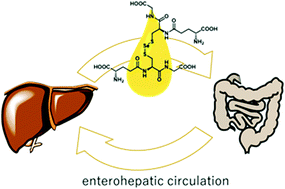Identification of the biliary selenium metabolite and the biological significance of selenium enterohepatic circulation†
Abstract
Although selenium (Se) is mainly excreted in urine, it has been reported that an unknown Se metabolite is excreted in bile. When we administered selenomethionine (SeMet), selenocyanate or selenite to rats, a common biliary selenometabolite was detected 10 min after administration. The amount of the selenometabolite originating from SeMet was less than that originating from the two inorganic Se compounds, selenocyanate and selenite, suggesting that the transformation from the methylated organic selenocompound, i.e., SeMet, was less efficient than that from the inorganic Se compounds. The common biliary selenometabolite was concretely identified as selenodiglutathione (GSSeSG) by two types of mass spectrometry, i.e., LC-inductively coupled mass spectrometry (ICP-MS) and LC-ESI-Q/TOF. The bile-drained rats had lower urinary Se levels than the sham-operated rats. In addition, the Se amounts in urine plus bile of the bile-drained rats were comparable to the Se amount in the urine of the sham-operated rats. These results suggest that the biliary selenometabolite, GSSeSG, was reabsorbed in the gut and finally excreted in urine. Enterohepatic circulation occurs to maintain Se status in the body.



 Please wait while we load your content...
Please wait while we load your content...